TDA7292 / TDA7265 / TDA7269 DIY Guide - 40W / 30W / 14W Stereo Single Chip Power Amplifiers
Recommended Experience : intermediate, knowledge of amplifiers, split rail power supplies, PCB etching, heatsink attaching, and mains qualification
Comparison
All of these chips are 11 pin Multiwatt devices that basically operate in the same circuit to provide a good quality stereo amplifier/
Quick facts
- Class AB
- Dual amplifiers in one chip
- Short circuit protection
- Mute/standby pin
- Gain: 30dB using datasheet components (adjustable 25/29 to 33 dB)
Performance difference
The table below is a comparison of key performance differences. Note that the voltage range is from absolute minimum to the maximum operating limits - for reliability, you should aim to use a voltage supply that is 2V under that limit.
All three chips are from STMicroelectronics, with some also made by UTC. The capability of each chip is significantly different, with the TDA7292 being the most capable, and the TDA7269 being the least.
All amplifiers are more focused to be Hi-Fi / AV chips for driving 8 ohm speakers, rather than driving 4 ohm speakers.
| Package | Voltage supply range | Power at 10% 1kHz THD - 8 ohms | Power at 10% 1kHz THD - 4 ohms | Power at 1% 1kHz THD - 8 ohms | Power at 1% 1kHz THD - 4 ohms | Peak current limit |
|---|---|---|---|---|---|---|
| TDA7292 | +/-8V to +/-33V | 40W + 40W from +/-26V | 31W + 31W from +/-18V | 30W + 30W from +/-26V | 24W + 24W from +/-18V | 5A |
| TDA7265B | +/-8V to +/-33V | 30W + 30W from +/-23V | - | 25W + 25W from +/-23V | - | 5A |
| TDA7265 | +/-5V to +/-25V | 25W + 25W from +/-20V | 25W + 25W from +/-16V | 20W + 20W from +/-20V | 20W + 20W from +/-16V | 4.5A |
| TDA7269A | +/-5V to +/-20V | 14W + 14W from +/-16V | 10W + 10W from +/-12.5V | 11W + 11W from +/-16V | 7.5W + 7.5W from +/-12.5V | 3A |
Note that TDA7265B seems to be an enhanced version of the TDA7265 that is almost as capable as the TDA7292. It has been graphed in the datasheet to reach 40W with +/-26V supply, but that is pushing it! It has no quoted rating into 4 ohm speakers, but it should work with 4 ohms with performance just shy of the TDA7292.
Datasheets
Guide
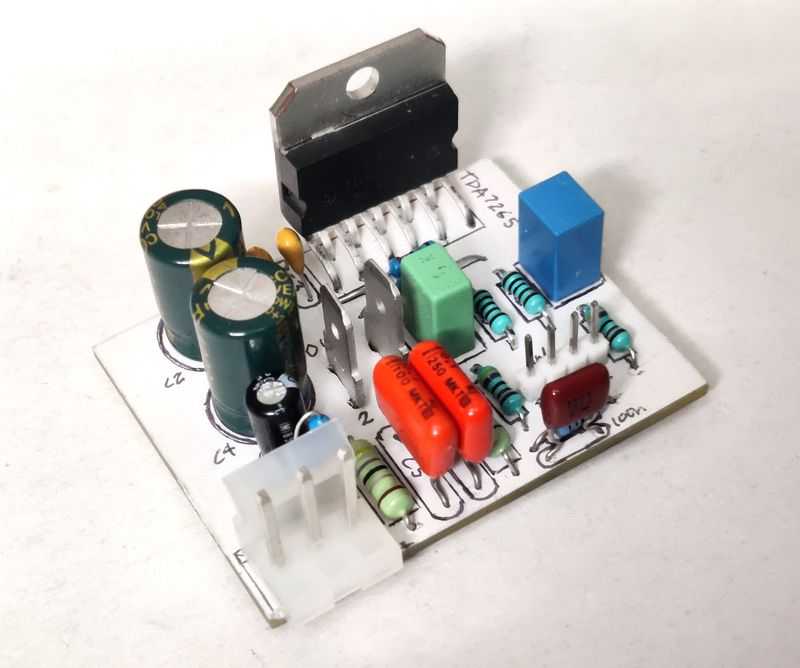
These simple single chip power amplifiers are popular, having started in the mid 2000's and all are still in production as of September 2022.
- Just one chip makes a capable amp for a stereo system (i.e., a homemade or upgraded midi system).
- One chip + speakers can improve the sound from a TV set.
- Two chips can make a powerful 2.1 PC speaker system (second one bridged for the subwoofer)
- Woofer, Mid and Tweeter amplifiers in active Hi-Fi bi-amp or tri-amp systems, thanks to their low distortion.
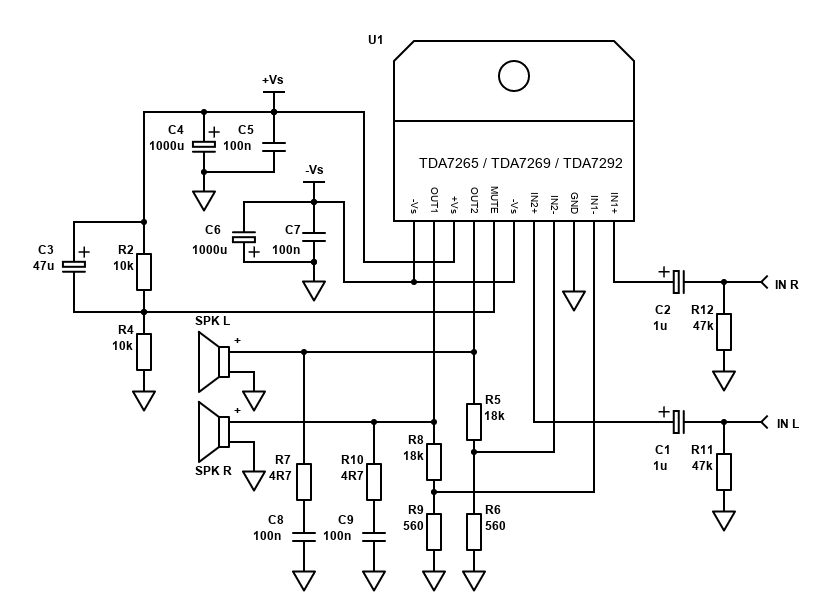
This amplifier is based on the typical applications in the ST Microelectronics datasheets for the chips, but with a simplified standby/mute circuit so you don't need an external microprocessor or switches to enable the amplifier. The performance from this circuit is very satisfactory.
You can try to make these amps on a Veroboard / Stripboard PCB, but you will have a tricky job to mount the IC onto the board, as well as risk of creating an amp that oscillates due to board layout. I have not tried myself on Stripboard. If you are happy with a fixed gain (of 30dB), you can consider the TDA7264 instead, which has single row of pins spaced 2.54mm apart.
A custom PCB is much better, and that's how I've built my amplifier. You can layout the tracks optimally, drill the holes, etch it then solder in the small number of components with minimal effort. The ST Microelectronics datasheets (linked above) contain suggested PCB layouts, or you can design your own and make it more compact for today's component sizes and the simplified mute circuit. See below for my hand drawn suggestion, which I've built and run daily.
See also my PCB Building Guide for a novice guide to drawing and etching your own PCBs using only cheap equipment.
The datasheet PCB layout is available in all datasheets except the TDA7269, so users of this chip, just refer to one of the other datasheets to see ST's layout. The TDA7265 has an alternative, but older layout. TDA7265B and TDA7292 also include single supply layouts. Do note that with all these layouts, the board extends under the heatsink, so plan your design and heatsink purchase appropriately.
Below is the PCB layout I designed. This is intended to be more compact than the datasheet version (size is 4.2cm x 5cm) and uses the simplified mute circuit. It uses single layer board but be aware that the speaker outputs and power rails are a little thin near the chip pins. This may limit maximum power output but should still be capable of handling intermittent current (like music and movies). This board does extend into the heatsink area, so mounting directly (via isolation) to a large heatsink attached to a case, for example, is not a problem.
Also note that the speaker outputs use PCB 6.3mm quick connect/spade terminals which have two pins. This allowed me to route the mute track to pin 5 under them, so be aware of using a different connector.

Below is a picture of the built board and amplifier. This UTC7265 amp now drives bass and mid for a centre speaker in my main 5.1 system.

Note: Not shown, but a heatsink IS required!
Components
| # | Type | Quantity |
|---|---|---|
| U1 | TDA7292, TDA7265, TDA7265B, or TDA7269A | 1 |
| R2,R4 | 10k ohm Resistor, ¼W Metal Film, 1% | 2 |
| R5,R8 | 18k ohm Resistor, ¼W Metal Film, 1% | 2 |
| R6,R9 | 560 ohm Resistor, ¼W Metal Film, 1% | 2 |
| R7,R10 | 4.7 ohm Resistor, 1W Carbon, 5% | 2 |
| R11,R12 | 47k ohm Resistor, ¼W Metal Film, 1% | 2 |
| C1,C2 | 1µF Capacitor, Polyester Film/Box (Best) or 16V+ Electrolytic | 2 |
| C3 | 47µF Capacitor, 35V+ Electrolytic (use 50V+ for TDA7292) | 1 |
| C4,C6 | 1000µF Capacitor, 35V+ Electrolytic (use 40V+ for TDA7292) | 2 |
| C5,C7 | 100nF Capacitor, 50V+ Ceramic X7R or MLCC | 2 |
| C8,C9 | 100nF Capacitor, 50V+ Polyester Film/Foil/Orange Drop (Best) or Ceramic X7R | 2 |
| In L,R | 2.54mm header 4-pin | 1 |
| +Vs,-Vs,GND | 3.96mm CH W2B Molex 5239/KK396 3-pin | 1 |
| Spk R,Spk L | 6.3mm Quick-Connect (Spade) PCB Disconnect | 1 |
| Heatsink, cable, connectors | ~ |
All resistors are recommended to be ¼W 1% metal film. The Zobel resistors (R7,R10) need to be minimum 1W resistors.
Input capacitors (C1 and C2) are best as 1µF polyester capacitor, which give a -3dB (half) cut-off frequency of 8 to 11Hz with the chips input impedance of 20k (min 15k). Electrolytic capacitors will also work.
Bypass capacitors (C5, C7) should be Ceramic or Multi-Layer Ceramic (MLCC). Zobel capacitors (C8, C9) are best as polyester, but ceramic will work too.
The rest of the capacitors are electrolytic. Their voltage rating must exceed one power supply rail - 35V should be fine for most amps but if you are pushing the TDA7292 up to +/-33V then get capacitors rated 40V or higher for reliability and bear in mind that you'll need a bigger PCB to accommodate them.
Ensure that electrolytic capacitors are connected the right way round - pay attention to C6 as the positive terminal is in ground, not -V supply.
Ceramic Bypass capacitors (C5, C7) should be close to the IC pins. The feedback resistors (R5, R8) should also be close to the IC pins.
Also added, but not mandatory, are R11 and R12. These resistors give a path for DC to discharge from C1/C2 or any capacitor on the output of a preamp (for example), without affecting the input impedance too much.
Do not run this amp without a good heatsink, it will get very hot very quickly and likely fail. Get a good heatsink, especially at high voltages, bridged or when driving 4 ohm speakers. The heatsink must also be insulated from the metal tab on the back on the chip, because this tab is connected to the -VS supply, not ground. This usually means mica washers, Kapton tape. Beware of Sil-Pads as they are often too thick and cannot transfer enough heat. Only if you are operating at low voltages can you get away with a small (medium-sized) isolated heatsink.
If you're choosing the TDA7292 / TDA7265B and run at higher power supply voltage, the heatsink should be even larger due to the greater power dissipation. Power dissipation could be 40W or higher when driving a 6 ohm speaker with +/-24V supply - see figure 15 in the TDA7292 datasheet. 40W is quite some heat to get rid of.
The gain using the components per datasheet is a little over 30dB. That's a good value, but if you prefer a little less gain using 22k for R5 and R8 and 1k R6 and R9 will give a gain of around 27dB. This is the gain I used in my build but avoid it for TDA7292 though.
Voltage gain is 1 + (R8/R9) for output 1, or 1 + (R5/R6) for output 2 e.g., for R9 of 560 ohm and R8 of 18k ohm: 1 + (18000/560) = 33.14. In dB this is 20 × log(33.14) (assuming an input voltage of 1V RMS), which equals 30.4dB. If adjusting the gain, do not go below 29dB for the TDA7292, or 25dB for TDA7265/TDA7265B/TDA7269A chips, as they will become unstable.
Speaker returns (-) should be both connected together at your PSU board 0V ground (after the capacitors), not the amplifier PCB. This is why my layout only contains the speaker + outputs.
Performance
After wired correctly, these chips make great amplifiers. All could be considered Hi-Fi, thanks to their low distortion, but carefully choose the trade-off between power output and supply voltages. Even though you can get some good power out of the TDA7292/TDA7265B especially, you'll need a big heatsink and decent PSU and this will add to the cost. For higher power stereo systems, I tend to consider two separate amplifiers (such as LM3886, or TDA7293 to TDA7296) better as the increased surface area makes it a bit easier to deal with the heat removal - the size of your heatsink will likely make the benefit of a smaller board worthless.
Power and distortion statistics are all listed in the datasheet and above. My recommendation (for all these chips) is to match them to speakers of 8 or 6 ohm minimum. Though 4 ohm loads are possible, they are pushing the current capabilities of the chips except at low power supply voltages.
A TDA7265 amplifier (the UTC version) now drives bass and mid for a tri-amplified centre speaker in my Hi-Fi system, with a voltage supply of +/-17V (from a 12V AC 100VA toroidal transformer). Though from this power supply the output will only be around 14W per channel (at 1% THD), as 40% of power goes to bass, 40% goes to mid and 20% to high/tweeter, it potentially has the equivalent of 85W amp, more than loud enough for a typical centre speaker! The tweeter is driven by an LM1875.
Mute/Standby pin 5
All chips include a slightly cumbersome mute/standby pin that you cannot leave floating, tie to ground or tie to +VS (doing so will either make the amplifier silent or explode!). Connected directly to +VS, and the amplifier is in standby mode.
Basically, you need to bring the pin 2.5V below +VS to take it out of standby, and then 6V below +VS to unmute.
The easiest way to do this is with a voltage divider (R2/R4), with a capacitor C3 between +VS and pin 5. This way, when the power is initially supplied, the capacitor looks like a short before it charges, putting the amplifier in standby to begin with.
As capacitor C3 charges, the voltage falls quite quickly 2.5V below, enabling the amplifier, and then 6V below +VS, taking it out of mute. This will take about 200ms and gives a pop-free startup.
With R2/R4 at 10k each, the voltage will eventually settle at ½ +VS, which should be fine if you are running voltages of +/-15V or more. At lower voltages, you'll need to reduce R4 to ensure the divider voltage is at least 7V below +VS (6V is 'typical', but 7V is the min difference needed).
If you're running off a really low voltage (the TDA7269 can work off +/-5V in theory), the voltage divider should be modified to reference between +VS and -VS instead of ground.
Microcontroller mute
The datasheet shows several circuits suitable for connecting to a microcontroller.
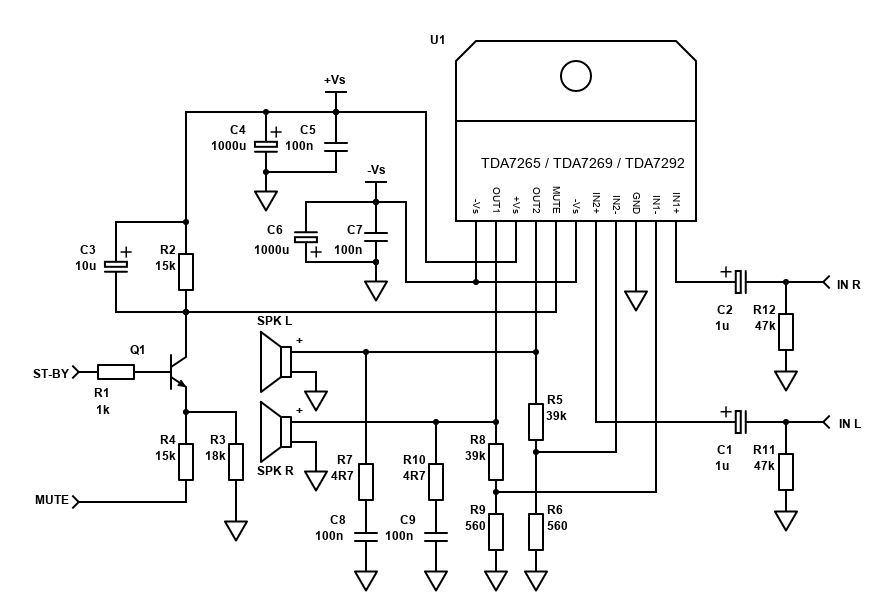
You would need to start with the MUTE input high and ST-BY input low. This would put pin 5 to +VS.
Upon switching on, R3 and R4 enter the circuit. With R4 referenced to +5V, the voltage should drop between 2.5 to 5V lower than +VS.
When R4 is referenced to 0V, the voltage at pin 5 should drop at least 6V below +VS.
If you want muting only driven by a microcontroller, you could do it with the below circuit. Here, you would need to bring the mute signal voltage to 0V to un-mute the amplifier. High (5V) would be muted (but not in standby).
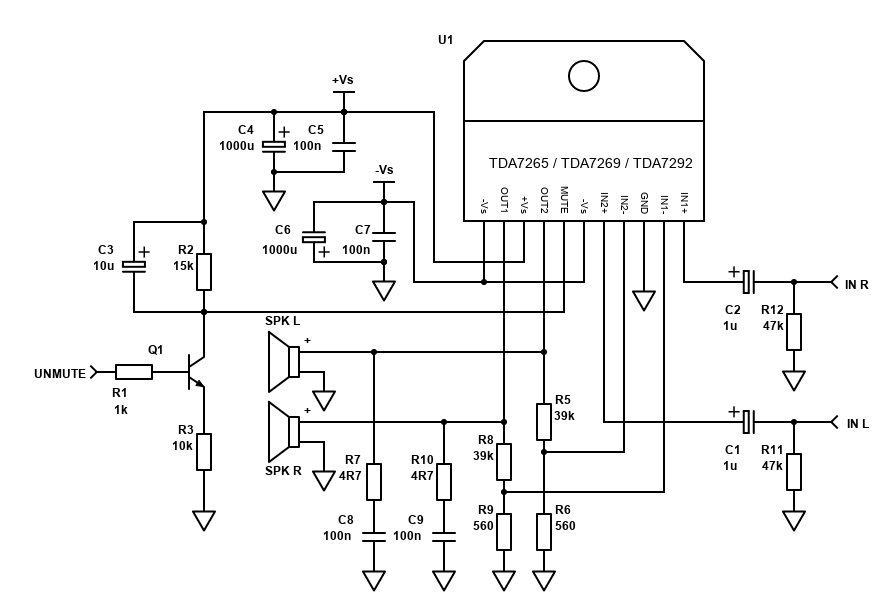
Power Supply
A power supply for this amp can be a simple split rail linear power supply. The maximum voltages per chip vary and are listed above, e.g., for the TDA7269A, +/-20V is the absolute maximum, so aim for +/-18V as a sensible maximum.
Wiring up a 2x 12VAC or 12-0-12 transformer will give +/-17V. 15VAC gets you to +/-21V, which is probably pushing the limit of the TDA7269A as the unloaded voltage will exceed the absolute maximum. +/-21V will work nicely for the TDA7265, or TDA7292 into 4 ohms. 18VAC pushes the voltage up to +/-25V, and this will give a decent helping of power output capability for the TDA7292 and TDA7265B into 8 ohms.
THE POWER SUPPLY REQUIRES MAINS VOLTAGE WIRING. DO NOT WIRE IT UNLESS YOU ARE SUITABLE QUALIFIED, DEATH OR SERIOUS INJURY MAY RESULT.
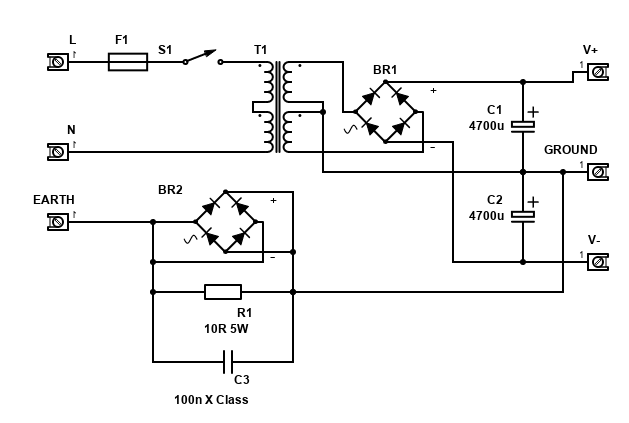
Your transformer size will depend on your amplifier, output voltage, and the number of amplifiers in your system.
For one TDA7269 (or others) amp, 50VA transformer should be sufficient if choosing 12V AC. Scale up for higher voltages - for music use I'd suggest 25VAC 80VA transformer the minimum for the TDA7292, with 100VA better.
Capacitors should be 10,000µF or bigger (2× 4,700uF per rail is also fine), rated at 35V minimum for +/-25V. You can only go for smaller voltage ratings if the unloaded voltage is comfortably below the capacitor's max voltage (for example 25V capacitors will be OK for +/-17V). Feel free to increase the capacitance but you may not get much additional benefit for the price involved. A fuse should be installed, I will leave it to you to work out what's appropriate because of the world-wide mains variations. Also be sure to correctly earth the supply and any metal casing around it.
The components on the earth and ground connections form a loop breaker. This is recommended construction because it can eliminate an earth loop. R1 is a 5W or better wire-wound resistor. The 100nF capacitor must be a Class-Y rated for 250V AC, you cannot use a 250V DC cap as it would fail open and burn if there ever was a fault causing mains to flow to earth. Check your country's rules and regulations before constructing this as it may be illegal. If so, omit all these components and connect the earth directly to ground but never disconnect the earth lead... it could save your life or somebody else's!
Bridge Version
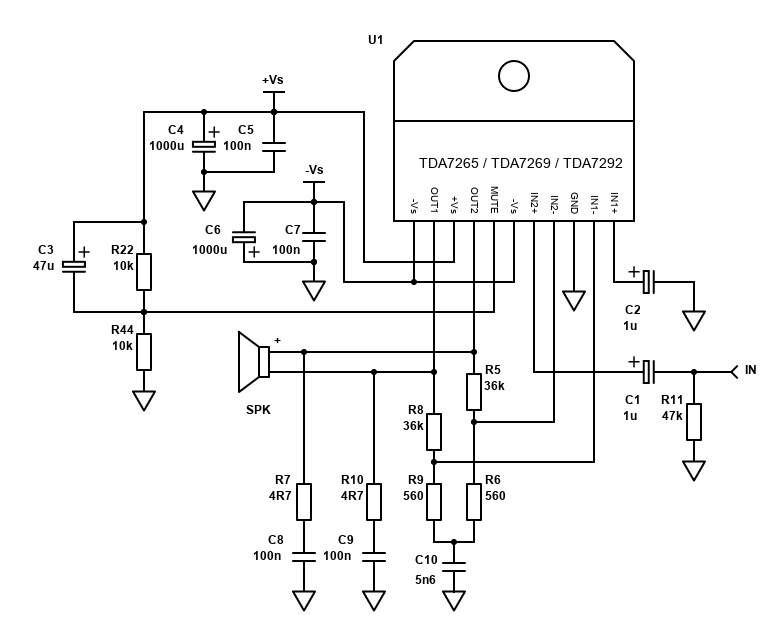
The datasheets also contain circuits for bridged circuits. Bridge circuits allow up to four times* as much power into the same impedance with the same voltage supply. In the example of a TDA7265 amplifier into 8 ohms with +/-16V, the power goes up from 12.5W to 42.5W, at 1% THD, or from 16W to 53W at 10% THD.
*As can be seen, the power output is also not four times greater (about 3.4x). This is because the output power into 4 ohms is not double what it is into 8 ohms, due to the current capability of these chips and other inefficiencies. Their intended use is in to 8 ohm speakers instead of 4 ohms and because bridging the amplifier will make each amplifier 'see' a 4 ohm load, limits apply.
Because each amplifier half is driving the equivalent of 4 ohms, do not attach a 4 ohm speaker - minimum 8 ohms only. Do not exceed +/-16V for the TDA7265, or +/-18V for the TDA7292, or +/-12V for TDA7269A. Make sure you use a big heatsink too. When wiring the loudspeaker, never short it to ground.
I have not yet tested a bridge version yet, but if you got a need for it and understand the limitations then it could be worth building. The cost will be higher, but it will still be cheap for a reasonably powerful amp. The disadvantage is complexity and distortion will be a bit worse, so it would be best used for woofer/subwoofer applications rather than mid/tweeter or full range. Bear in mind that there are many ICs that are already bridged and will be simpler (e.g., the STA540).
The power supply for the bridge version is the same as above but consider increasing the transformer VA rating (ideally double). 100VA should be fine for driving an 8 ohm speaker with +/-16V (so choose 12V AC). For a stereo bridged system, you'll need two chips and consider a transformer of 160VA upwards.
Single Supply
If you have a single supply system, the ST datasheets all give single supply alternatives. These are pretty much as per the split supply versions, but the ground pin 9 is lifted from the real ground with a capacitor, and the feedback resistors taken back to pin 9 instead of ground. Internally, the chip will created a virtual ground at around ½ +VS DC voltage (smoothed by C2).
This ½ DC voltage will appear on the output too though, so needs to be removed by the large DC blocking capacitors C9 and C10 on each output pin. 470µF is the minimum size suggested, but for better bass, aim for 1000µF, or 2,200µF for 4 ohm speakers.
Therefore, the cost is extra resistors and capacitors, including large 1,000µF capacitor in series with the speaker which will be quite expensive in cost and room that is consumes on the PCB. Making it smaller will affect bass response - 1000µF will get down to 20Hz for 8 ohms, 40Hz for 4 ohms. The calculation for the cutoff is 1/(2πRC) - e.g., for 8 ohms, 1000µF it's: 1/(2 × 3.14159 × 8 × 0.001) = 20Hz.
Do note that the single supply version will also have quite loud power on and off thumps through the speaker. This will be due to the capacitors charging and discharging during the power cycle. The best way to solve this is an external muting circuit.
In theory, the single supply voltage at +VS can be double what the equivalent split rail voltage is (so about +40V should be ok for a TDA7265). The datasheets make no mention of this though so use caution.
I recommend you purchase a good quality (has audio as a stated purpose) SMPS (switching power supply) for the single supply version of the amp. This will give good performance and avoid the need for transformer and mains wiring.
However, if you have a transformer available that only has one secondary and isn't centre tapped, then you could use that to build a single supply linear PSU:
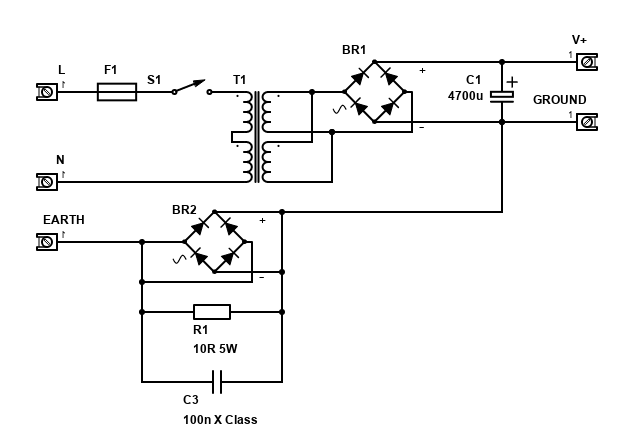
The VA rating will need to be the same as the split rail PSU.
No datasheet suggests a single supply bridge circuit, and I've not been able to experiment building one myself, but it's hard to recommend a BTL single supply version, especially when there are amplifiers nowadays that would do the job cheaper and safer (like STA540).
Conclusion
These chips are still available today, and are great for building a medium power, but great sounding, Hi-Fi amplifier. The TDA7265 I've used is a good compromise between cost and performance as the TDA7292 is more expensive and rarer. These chips are known to be used in Hi-Fi and PC speaker sound systems (Klipsch ProMedia 2.1 uses it).
As there are two amplifiers on one chip, it does allow you to make a small stereo system (see my boards above), or a pretty powerful mono bridged amplifier.
I use a UTC TDA7265 amplifier in my tri-amplified Klipsch Reference R34-C centre speaker in my 5.1 system, which is doing a good job as a centre speaker now that it's driven by three amps (two in the TDA7265) and the mediocre passive crossover replaced with an active one.
